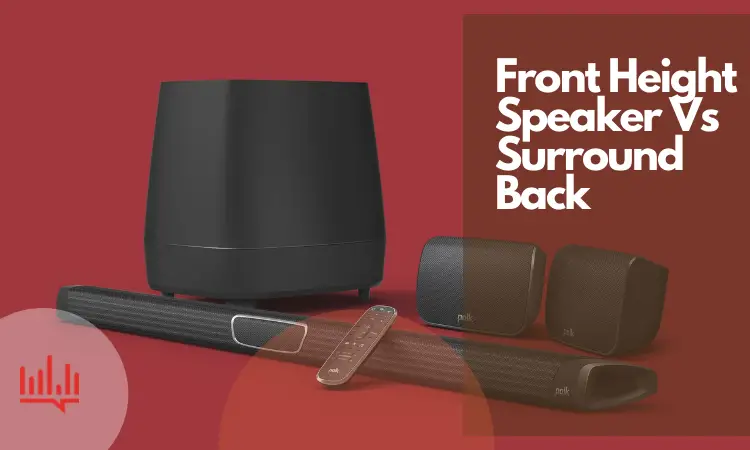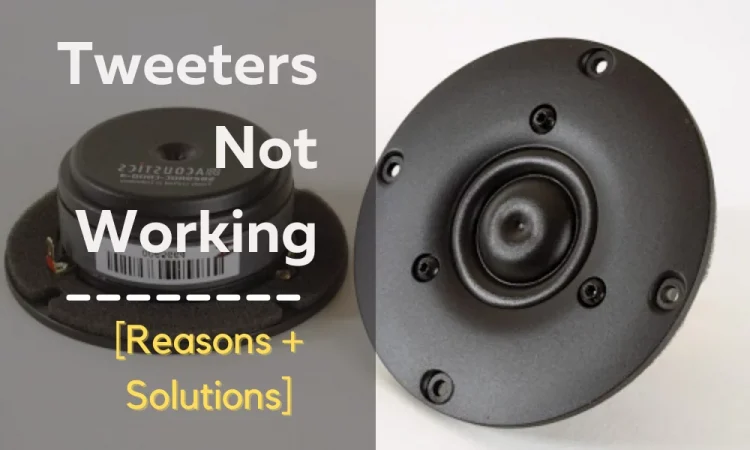If you are a music enthusiast, you must be screened through the market. But finding the best speakers is not easy.
There are different categories of speakers which makes it difficult to find the right fit.
one should you go for between Mid-range speakers VS Full range speakers?
Firstly, full-range speakers produce a high audibility frequency range. But mid-range speakers offer mid-range sound quality and are more configurable. Mid-range speakers are commonly cone-shaped and belong to the component speaker family. Whereas full-range speakers have two speakers with the same central axis and many drivers.
That was just the tip of the iceberg. There is more for you to know. For your convenience, we’ve explained the details into several categories.
So, without further ado, let’s get started.
What Are Mid Range and Full Range Speakers?
A speaker frequency range is to measure how long of a range of sound it can produce. It depends on the number range ie, a lower number means a lower tone.
In most speaker designs, a crossover network is used to produce frequency. It’s used to convey certain frequency bands to different drivers.
Again, multiple drivers are frequently used in speaker designs.
As a result, speakers with several drivers efficiently reproduce distinct ranges of frequencies.
These frequencies are within the total audio stream to benefit everyone.
So, firstly just for the basis of this article, let’s discuss what midrange and full-range speakers are.
Mid Range Speakers
Midrange speakers are made to deliver frequencies in the center of the spectrum. They usually vary from 150 to 5,000 Hz.
Midrange speakers don’t sound particularly well on their own.

So, they are added to other accessories for the sound. It’s perhaps more important to produce mid-range sounds as the name suggests.
This is because most audible sounds are produced in this range. Different instrumental music sounds good in these speakers.
Full Range Speakers
Coaxial speakers are usually referred to as “full-range” speakers.
This is due to the fact that they can produce a larger spectrum of audio frequencies with a single unit.
These speakers employ the same types of drivers as component speakers.
These speakers are commonly used as parts of speakers having a woofer and tweeter. In most surround sound systems, coaxial speakers are usually used.
However, they are merged into one for saving money and space. A woofer with a tweeter positioned on top is the most typical arrangement.
But 3-way full-range speakers come with a woofer, mid-range, and tweeter. They are generally of three categories:
2 Way Speakers
The most common form of automobile speaker is a two-way speaker. They have a main woofer for the lower frequencies.
Also, they have a little tweeter in the middle for the higher frequencies.
3 Way Speakers
Three-way speakers are similar to two-way speakers except for one feature. They have an additional midrange driver.

This is to provide additional clarity and detail in the mid-frequency range.
4 Way Speakers
Four-way speakers take the same configurations as three-way speakers. Then they add what is called a “super tweeter” next to the standard tweeter.
This is to handle the ultra-high frequencies. So, obviously, they are quite an upgrade.
Mid Range Vs Full Range Speakers: Head To Head Comparison
Both full-range and midrange speakers are excellent options for improving the audio in your vehicle.
However, just because they have similar appearances does not imply that they execute the same activities. So, here’s a sneak peek of the differences:
| Features | Full Range Speakers | Mid Range Speakers |
| Frequency | Below 100 Hz | 150Hz and 5,000Hz |
| Categories | 2 way, 3 way, and 4-way speakers | Installed in component speakers to increase sound quality |
| Usage | Used as a unit independently for maximum experience | Used as a central speaker with woofer and tweeter |
This was only a small part of the whole debate. So, let’s move on to the details!
Mid Range Vs Full Range Speakers: Detailed Comparison
Choosing between two ranges of speaker can be quite tough. However, don’t get worried just yet. The differences between these aren’t as complicated as differentiating between 6.5 and 8 inch ceiling speakers.
We’ve discussed all the features of the two speakers in detail down below:
Sound Quality
The frequency response of mid-range speakers is around 150 Hz to 5 kHz. Mid-range drivers are designed to generate the mid-range of the frequency spectrum.
However, the frequency responses of different midrange drivers are plainly distinct. These distinct speaker crossovers send these drivers different frequency bands.
As a result, stating a specific range with certainty is challenging.

Mid-range speakers are in charge of generating the mids. They also come with woofers and tweeters.
The woofer would be required for a speaker with a midrange driver to handle the low-end.
They also have a tweeter to cover the high-end to create the entire range of audible frequencies.
But full-range speakers sound significantly better than typical low-end single cone speakers.
Even some are added with Whizzer cones to apparently improve sound quality. For the greatest results, full-range speakers have a form of 2-way design.
In this, the duty of producing sound is split between them. This allows for a wide range of sounds to be created.
Full-range speakers fail to reproduce frequencies below 100 Hz.
You may also notice frequency interference. Subwoofers are typically utilized for this as they produce a punchier, more powerful bass sound.
Not just this, the stereo image also isn’t fantastic with full-range speakers. These drawbacks are there even though they can handle all of the frequencies in the spectrum.
As we analyzed, it is due to the fact that the sound drivers are too near together.
So, if you talk about sound quality, you can go for full-range speakers. They are best even without the need for any addons.
Winners: Full-range Speaker
Easy Installation
Now, let’s talk about a topic where you need to put in the effort. If you are a newbie, installing your speaker can be quite a task for you.
If you want to take all the benefits of a speaker, you’ll need to have solid technical skills.
Installation is straightforward and quick with full-range speakers. When you have the necessary tools, you can install these speakers in a matter of minutes.
You simply have one input connected to the handle. It is in contrast to mid-range speakers.
In mid-range speakers, you must manage three connections and three sets of speaker wires.
You’ll also have a less difficult upgrade available for your factory system. And finally, you’ll be able to enjoy higher-quality audio sooner.
If you can’t install a pair of speakers and don’t want to pay more, choose full-range speakers.
And if you are looking for some well-built models, here are some 3-way full-range speakers.
Winner: Full-range Speakers
Compatibility
If you are choosing the speaker for your vehicle, the size and fit have a great role to play here.
So, you may have to choose between 5.25 and 6.5 speakers depending on your needs.
The majority of full-range speakers fit into the gaps left by exiting OEM or factory speakers.
One of the key reasons why coaxial or full-range speakers are more commonly used is this.
Midrange speakers are not for all car models. This is because they need more space and have complicated installation requirements.
This is also dependent on the kind of car you select. So, keep this in mind before choosing one.
So, if you are considering buying a speaker that will well fit your car or any other vehicle, it will be safer to go for a full-range speaker.
Winner: Full-range speakers
Customization
Two woofers, tweeters, and two crossovers make up a conventional mid-range speaker system.
Some have additional drivers, such as subwoofers or mid-range drivers. Super-tweeters can be included in a more advanced design for improved sound quality.
These tweeters can also be troubleshot easily using a few techniques.
You can get on-axis and off-axis responses using these drivers. When you place the speakers in front of the listener, you’ll get an on-axis response.
It’ll give a superior higher-frequency performance. If you prefer bass, turn the speakers away from the listener to get an off-axis response.
On the other hand, if you choose full-range speakers, you won’t have much control. You won’t know how your stereo upgrade works and appears after installation.
They’ll fit in a variety of vehicles and provide a fair sonic enhancement, but that’s about it.
When it comes to customization, mid-range speakers are a superior choice.
Even if you’re designing a custom automotive audio system, these speakers are used.
Because of their sophisticated architecture, you can attain the best sound quality. This is done by inserting different drivers anywhere you choose.
So, if you want full freedom in customizing your music system, you can go for mid-range speakers.
So, if you want to buy a 2-way full-range speaker, here are some to go for:
Winner: Full-range Speakers
Cost
Cost can be a crucial factor to consider if you are on a budget to seek the perfect speaker. Because OEM car audio system design often puts cost above quality.
Most OEM car audio systems now feature full-range speakers.
Aftermarket car audio vendors also sell these speakers. They are also replacing factory car speakers with high-quality aftermarket ones.
It’s frequently the most cost-effective car audio update.
Mid-range speakers require significantly more resources and time to produce.
The extra cost is passed on to the consumer, which is why some speaker types are more expensive.
For this reason, if you want to cut your budget, full-range speakers are the ones for you.
Winner: Full-range Speaker
Testing Method
Now, do you have an old speaker and want to know what frequency it has?
Well, you can know about it at your home easily by playing a few songs.
For testing mid-range speakers, you can play ‘I Hope That I Don’t Fall In Love With You’ by Tom Waits or ‘I Put A Spell On You by Nina Simone.
When you can hear the songs smoothly and with good bass, your speaker is surely a midrange speaker.
If you hear any bumpy or peaky sound, then your speaker is not mid-range. The same goes for full-range speakers.
You can test it ‘ Light of the Seven’ by Ramid Djawadi and ‘Pran’s Departure’ by Mike Oldfield.
Final Verdict
The ultimate decision of choosing the right speaker comes down to your preferences. However, full range speaker takes an edge in most situations.
Now, here’s table you can look into for an overall summary:
That’s all on mid-range and full-range speakers.
FAQs
What Hz is best for bass?
In most subwoofers, a frequency range of 20-120 Hz is ideal for bass. The more bass you can get, the lower the Hz. This Hz range is found in some of the greatest subwoofers on the market. If you’re looking for a subwoofer with a set Hz rating, be sure it’s around 80 Hz if the bass is crucial to you.
Can I use a normal speaker as a woofer?
No, a regular speaker is unable to produce low-frequency sound. So it cannot be utilized as a subwoofer. A conventional speaker cannot replace a subwoofer because of its special role. A woofer can be used to generate low bass tones, although it still pales in comparison to a sub.
Conclusion
That is all about mid-range speakers vs full-range speakers. Always keep in mind that to choose the best one, you need proper guidance.
We really hope that we could give that proper idea to you. Please contact us if you have any additional questions. We’d be delighted to respond.
Have a wonderful day until then!





